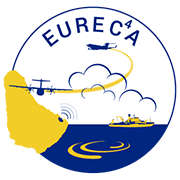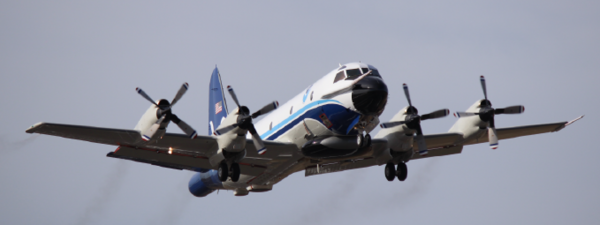WP-3D Orion
NOAA will deploy a WP-3D Orion research aircraft to Barbados for the ATOMIC field programme's contribution to EUREC4A. It has a cruising speed of 250 kn, or about 120 m/s and ceiling near 8 km. Its endurance is 8-11 hours depending on flight level and payload. It will be based out of Barbados with 100 flight hours for research flights between 15 January and 13 February 2020. The principal role of the WP-3D is to provide atmospheric and oceanic context to the observations of the R/V Ronald H. Brown and to directly measure cloud, boundary-layer, and surface properties on a wide scale. This will feature the spatial mobility and unique measurements of the aircraft. The research flights will thus complement those of HALO in dropping sondes to characterize the large scale environment, with an emphasis on linking the upwind environment being sampled by the R/V Ronald H. Brown and the  NTAS buoy, to the nearer-shore measurement area being intensively sampled by the other aircraft. In addition to dropsondes the WP-3D will deploy AXBTs for additional ocean measurements.
NTAS buoy, to the nearer-shore measurement area being intensively sampled by the other aircraft. In addition to dropsondes the WP-3D will deploy AXBTs for additional ocean measurements.
Instrumentation:
| Flight level data | Atmospheric state variables including temperature, pressure, winds and humidity. |
| Aircraft state data | The P-3 logs some 150 navigational and environmental variables (mostly at flight level) including motion information from a Novatel IMU. |
| AXBT | The Airborne EXpendable BathyThermograph (AXBT) measures ocean temperature as a function of depth. The temperature profiles nominally produced are from the surface to 350 m, at 1.5 m vertical intervals. One mode will be a lawnmower type grid about 1 deg by 0.5 deg with 15 sondes. The altitude of the AXBT grid will be selected to complement other observations; for example, cloud or subcloud sampling or stepped profiles within the boundary layer. |
| Scanning precipitation radar | The TDR (or tail doppler radar) is a dual beam (forward and aft, 20 deg) conical scanning X-band system. The sensitivity is about -22 dBZ at a range of 1 km. The beamwidth is 1.35º (horizontal) and 1.9º (vertical). Jorgensen, D.P., Matejka, T. , and DuGranrut, J.D., 1996: Meteorl. Atmos. Phys. 59: 83. doi.org/10.1007/BF01032002 |
| Dropsondes | Dropsonde system using Vaisala RD-41s sondes to measure temperature with an accuracy of 0.2 ºC, humidity with an accuracy of 2 %RH, pressure with an accuracy of 0.4 hPa. Winds are derived from GPS position measurements with an estimated accuracy of 0.1 m/s. A nominal vertical resolution after processing is 5 m. |
| Stepped frequency microwave radiometer | Stepped frequency microwave radiometer (SFMR). Measures 10m wind speed, rainrate. The SFMR measures surface emissions at six microwave frequencies (5 -7 GHz) to estimate 10-m wind speed and rain rate. See Sapp, JW., et al., 2019: Stepped Frequency Microwave Radiometer Wind-Speed Retrieval Improvements. Remote Sens., 11, 214; doi.org/10.3390/rs11030214 |
| DMT cloud probes | A variety of cloud microphysical probes from Droplet Measurement Technology (DMT). Except for the liquid water content (LWC) sensor, all systems are size spectrometers with the diameter ranges of: 0.5 μm - 50 μm 2-50 μm , CCP; 25 μm - 1.5 mm, CIP; 100 μm - 6.2 mm, PIP, Details on the probes can be obtained from DMT. The liquid water content probe is sensitive over the range from 0.05 gm-3 to 3 gm-3 |
| Wave radar | A Ku-band wave radar measures the 2D wave spectra, rainrate and mean sea state |
| Cloud radar | The W-band (94 Ghz) radar profiles cloud, precipation, vertical motion and the mean sea state. |
| Stable isotopologues | Stable water isotopologue measurements (Oregon State University). |
| SSTs | A Heimann radiometer provides measurements of sea-surface temperature. |
PI/Contact:
Chris Fairall of the NOAA Physical Science Division in Boulder is the PI for the P3. All general questions should be directed to him. Additional points of contact are Paquita Zuidema (U. Miami) or, for instrument specific questions, contact the instrument PIs identified above.

